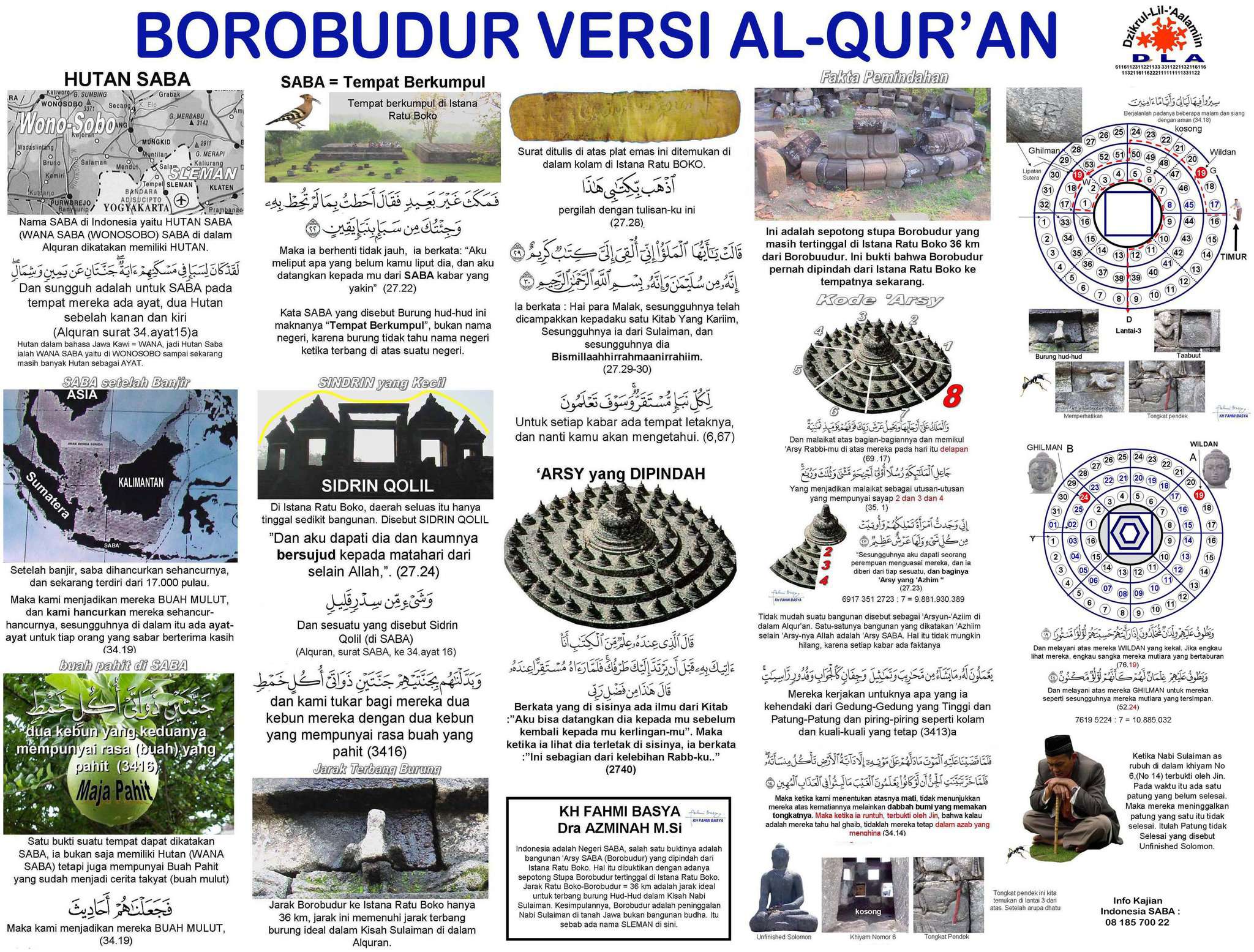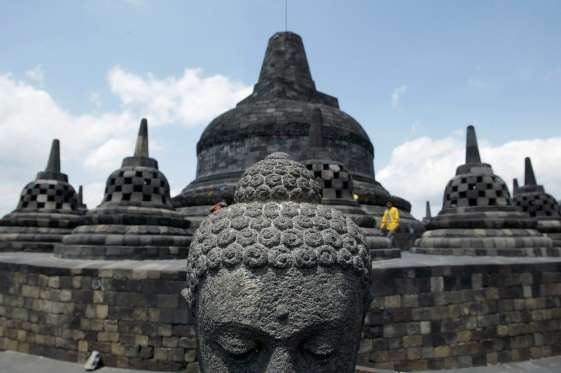It was the kind of view people would pay to see. Fahmi Basya had led a dozen people up a hill in Magelang, Central Java, that looked down at a wide valley below, in a video posted to YouTube. A chilly fog hung low over the horizon, and beyond that was Borobudur, a majestic Buddhist temple—the largest in the world—that has sat watch over the valley since the ninth century.
The view was gorgeous, but that wasn’t why any of them were there. Fahmi and his followers were on the hill to search for evidence that everything we think we know about Borobudur is wrong. It wasn’t the grand work of the Shailendra dynasty, a family of royals who ruled parts of Java and Sumatra from 650 CE to 1025 CE, he later told me. Hell, it wasn’t even Buddhist.
Videos by VICE
No, to Fahmi, Borobudur is clearly the work of an Islamic ruler. But his theories go much further. Fahmi believes that Borobudur is part of the ancient Islamic kingdom of Sheba, a wealthy and peaceful country that was ruled by the Queen of Sheba (Bilqis in the Quran) and King Solomon, a prophet mentioned in all Abrahamic religions. Borobudur was actually a temple built for King Solomon—a temple that could fly and traverse oceans like some kind of ancient version of those giant UFOs from the movie Independence Day.
“I’ve always believed that Borobudur is some sort of UFO,” Fahmi once told his followers at a seminar five years ago.
It’s moments like these that could make a person more in-touch with reality question how anyone could believe Fahmi’s claims. But plenty do. One tour guide at Borobudur told me that he often sees people wandering around the temple grounds with one of Fahmi’s books in their hand.
“I’ve seen people scratch the gaps in the stone reliefs with sharp objects to see if it’s a door to a room that can be opened with certain keys,” Murad told me. “It’s that bad.”
This is what convinced me to seek out Fahmi. He’s not the first person to suggest that Indonesia is actually part of some far-grander forgotten history. The leader of the Swissindo cult—a group that claims it has access to a literal mountain of gold and platinum and promises to wipe its followers’ debts clean—spins a similar yarn that puts Indonesia at the center of every massive global event in recent history.
Others, like Brazilian writer Arysio Santos, believes that Indonesia is actually the lost city Atlantis. And Stephen Oppenheimer, a British writer, has theorized that Indonesia, not Mesopotamia, is the real heart of all human civilization.
But in the annals of batshit crazy ideas, this “Borobudur is also King Solomon’s ancient UFO” theory might just take the cake. Here’s what Fahmi believes: Sheba, a nation that historians believe was in modern-day Yemen, was actually down here in Central Java, where it stretched from Yogyakarta to Wonosobo in the south and north, and from Boyolali to Kulonprogo in the east and west.
Sheba was, in short, a utopia for its time. It was an incredibly wealthy and peaceful place ruled by a wonderful queen and a man who is considered a prophet by Muslims. King Solomon was a gifted man. He could speak to animals and he controlled an army of jinn—spirits found in the Quran—and humans in battle. One day, he moved his throne to the palace of the Queen of Sheba at an amazing speed, possibly with the help of the jinn.
Borobudur was this throne, according to Fahmi. And King Solomon moved it to Magelang with the help of the jinn—he says the complex actually flew through the air—because that’s where Sheba actually was. Fahmi then takes his theories deeper into the realm of the unreal by arguing that it was the jinn themselves who built Borobudur.
“There is proof that Borobudur wasn’t built by humans,” Fahmi told me. “It was impossible to carve the reliefs. Only jinn can do that.”
These stone reliefs, which are similar to other reliefs carved in different temples in different countries at the time, like Cambodia’s Angkor Wat complex, play a huge part in Fahmi’s theories. These reliefs, which historians say tell the life of Buddha, are actually stories from the Quran, according to Fahmi. He laid out the details of this theory, as well as 39 other pieces of proof, in three books he’s written since 2012 that all say the stone reliefs tell readers about the glories of King Solomon’s kingdoms.

Now, no actual scholar believes any of this, a fact that seems to frustrate Fahmi. Last November, he showed up at an archeology festival at Yogyakarta’s Gadjah Mada University and challenged the academics in the crowd to prove that Borobudur wasn’t actually King Solomon’s flying temple.
Fahmi is himself an academic—he’s a math professor at UIN Syarif Hidayatullah—and he is adamant that all of his findings are based in the field of “Quranic Science,” and on research he conducted himself between 1982 and 2012 at Borobudur. In the video, Fahmi walked around the Buddhist temple and pointed out several stone reliefs that he believed were illustrations of stories from the Quran.
“There are some stories about the Queen as well,” Fahmi told me. “It looks exactly the same as in the Quran. It’s clear that Borobudur isn’t a Buddhist relic.”

Eventually, I began to lose track of his explanations. The so-called proof he kept talking about was too far-fetched for me to swallow. But I kept listening because his commitment to this story is still pretty amazing. Fahmi isn’t some weekend conspiracy theorist. He’s not hopping on the latest pseudo-science trend like all of Indonesia’s Flat Earthers. He’s been pushing this story for the better part of a decade, telling people that the idea first came to him in a dream he had in prison.
Fahmi was jailed as an activist back during the repressive New Order years, and while he was in prison, he claimed that Indonesia’s founding father Sukarno met him in a dream. In the dream, Sukarno agreed with Fahmi’s theories that Borobudur was actually an Islamic UFO, not a Buddhist temple.
But he kept this dream secret for years, perhaps too scared to make waves after spending time behind bars. In 2008, he started to write his ideas down. “I finally put it out there on the internet,” he told me.
Soon, his ideas started to make their way through Indonesia, where an audience receptive to conspiracy theories started to take his ideas as fact, regardless of how far-fetched they really seemed. It’s almost like the people who once believed that Indonesia was the cradle of civilization or the lost city of Atlantis found a new theory to believe in, one that conveniently recast a temple recognized as a vital part of global culture as an Islamic relic, not a Buddhist one.
Fahmi seized on this newfound popularity, holding “expeditions,” to explore “ancient Sheba,” in Central Java. To date, he’s done 15 of these fact-finding missions, charging Rp 3 million ($217 USD) per-person for each one. He’s also regularly invited to speak at mosques and has more than 18,000 followers on his Facebook account.
But sometimes his attempts to prove that all of this is real cross the line from the absurd to the cringeworthy. For a while, Fahmi was telling people that Borobudur was actually King Solomon’s final resting place as well as his temple. So, of course, it likely contained some of the prophet’s treasures. In a video now deleted from his YouTube—but thankfully preserved online—his followers attempt to swipe a plastic card in a gap between the stone reliefs like it’s some kind of ATM. Then, in bit of a crude animation, the relief seems to open up to display a drawer of treasure.
Archaeologists have flat-out rejected Fahmi’s theories. If Islam forbids its followers from creating and worshipping statues and idols—why would King Solomon build a massive temple, one of the largest in the world, full of statues and idols?
And if “Quranic science” and Islamic mathematics are the basis of his Sheba theories, then Fahmi must have forgotten that Hinduism and Buddhism each have their own mathematical systems too, said Niken Wirasanti, an archaeologist from Gadjah Mada University.
“The texts in Borobudur were written in old Javanese,” Niken told me. “If Borobudur was an Islamic relic, shouldn’t the text be written in Arabic?”
Archaeologist Goenawan A. Sambodo, who’s an expert on ancient Javanese script, agreed with his colleague’s assessment. There’s not a shred of evidence supporting Fahmi’s ideas. But that hasn’t stopped some Islamic schools from teaching his ideas as fact, Goenawan said with concern.
“This is obviously a Buddhist relic,” Goenawan told me. “Even if it was based on Islamic mathematics or research, there are lots of scientific references that show that Borobudur is a Buddhist temple.”
I tried to talk to Fahmi about some of the plot holes in their theories, but he refused to budge. Instead, he doubled-down on his ideas, telling me that I only had to look at the name of the district that lies just north of Yogyakarta city.
The district is called Sleman, which sounds a bit like Solomon when you say it aloud.
“The only Muslim prophet with a Javanese name is Solomon,” Fahmi said. “This place called Sleman is his legacy. You must remember that.”
But, Solomon was in the Christian Bible too. And millions of Indonesians have Arabic names. But the moment I tried to suggest any of this, Fahmi hung up the phone. I guess, for him, it doesn’t really matter what the rest of the world thinks—at least not when it concerns telling him that temple’s can’t fly.
More
From VICE
-

Illustration by Reesa. -

Screenshot: GOG.com -

Screenshot: Sierra Studios -

Screenshot: Electronic Arts
